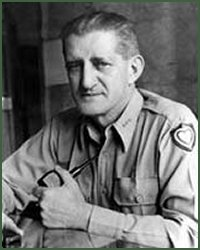John Reed Hodge was born in Golconda, IL, on 12 June 1893. Hodge attended Southern Illinois Teachers College and the University of Illinois. His military service began in 1917 when he entered a reserve officer training program at Fort Sheridan, IL, and was commissioned as a Second Lieutenant later that year. In World War I, he served in France and Luxembourg.
After WWI ended, Hodge remained in the Army and taught military science at Mississippi State University from 1921-1925. In 1926, he graduated from the Infantry School. After a posting to Hawaii, Hodge graduated from the Command and General Staff School, the Army War College, and the Air Corps Tactical School.
Hodge was part of the staff of VII Corps, commanded by Maj. Gen. J. Lawton Collins, when World War II broke out. Immediately thereafter, he was promoted to lieutenant colonel and made Chief of Staff of VII Corps. In June 1942, he was promoted to brigadier general and made Deputy Commander of the 25th Infantry Division, commanded by Maj. Gen. J. Lawton Collins. He fought with the 25th Infantry Division at Guadalcanal. In April 1943, he was promoted to major general and given command of the 23rd Infantry Division, more commonly known as the Americal Division. When the offensive on New Georgia bogged down, he was briefly sent in to reorganize the offensive.
Maj. Gen. Hodge commanded the Americal Division at Bougainville, then took command of XXIV Corps of the U.S. 10th Army in April 1944. His unit went ashore at Leyte on 20 October 1944 and fought at Okinawa during April-June 1945. He was promoted to lieutenant general in August 1945, after the end of the Okinawa campaign.
After WWII, under the orders of General of the Army Douglas MacArthur, Lt. Gen. John R. Hodge took his XXIV Corps to Korea, landing at Incheon on 8 September 1945. All Japanese forces in Korea south of the 38th parallel formally surrendered to Hodge the next day, 9 September 1945. Hodge was then appointed the commander of U.S. Armed Forces in Korea and tasked with the restoration of Korean independence. He established a military government shortly thereafter.
From 1945 to 1948, Hodge was the military governor of South Korea under the United States Army Military Government in Korea (USAMGIK). USAMGIK was the official ruling body of the southern half of the Korean Peninsula from 8 September 1945 to 15 August 1948. Many of the foundations for the modern South Korean system were laid during this period.
Hodge then returned to Fort Bragg, NC, where he served as Commanding General of V Corps from 1 November 1948 to 31 August 1950.
After the outbreak of the Korean War in 1950, Hodge was named Commanding General of the U.S. Third Army, based in the United States; not in Korea. During the Korean War, Third Army acted primarily as a command and training force for army units in the United States. He commanded Third Army from 1950 to 1952.
On 5 July 1952, Hodge received his fourth star and was made Chief, Army Field Forces; his last command. [Formerly known as Army Ground Forces, it became Army Field Forces in 1948, Continental Army Command (CONARC) in 1955, and was ultimately divided into United States Army Forces Command (FORSCOM) and United States Army Training and Doctrine Command (TRADOC) in 1973.] General Hodge retired in June 1953.
Medals and Awards
Army Distinguished Service Medal with Bronze Oak Leaf Cluster
Navy Distinguished Service Medal
Legion of Merit
Purple Heart with Bronze Oak Leaf Cluster
Air Medal
World War I Victory Medal
Occupation of Germany World War I Medal
American Defense Service Medal
American Campaign Medal
Asiatic-Pacific Campaign Medal with 2 Silver Stars and Arrowhead Device
World War II Victory Medal
Army of Occupation Medal
National Defense Service Medal
Korean Service Medal with 3 Bronze Stars and Arrowhead Device
Death and Burial
General John R. Hodge died at Walter Reed Army Hospital in Washington, DC, on 12 November 1963, at age 70.

PRIVATE CITIZENS SUPPORTING AMERICA'S HERITAGE
American
War Memorials Overseas, Inc.
War Memorials Overseas, Inc.
Hodge John Reed
Name:
John Reed Hodge
Rank:
General
Serial Number:
Unit:
XXIV Corps
Date of Death:
1963-11-12
State:
Illinois
Cemetery:
Arlington National Cemetery, Arlington, Arlington County, Virginia,
Plot:
Section 34, Grave 157-A
Row:
Grave:
Decoration:
Army Distinguished Service Medal with Bronze Oak Leaf Cluster
Comments:
